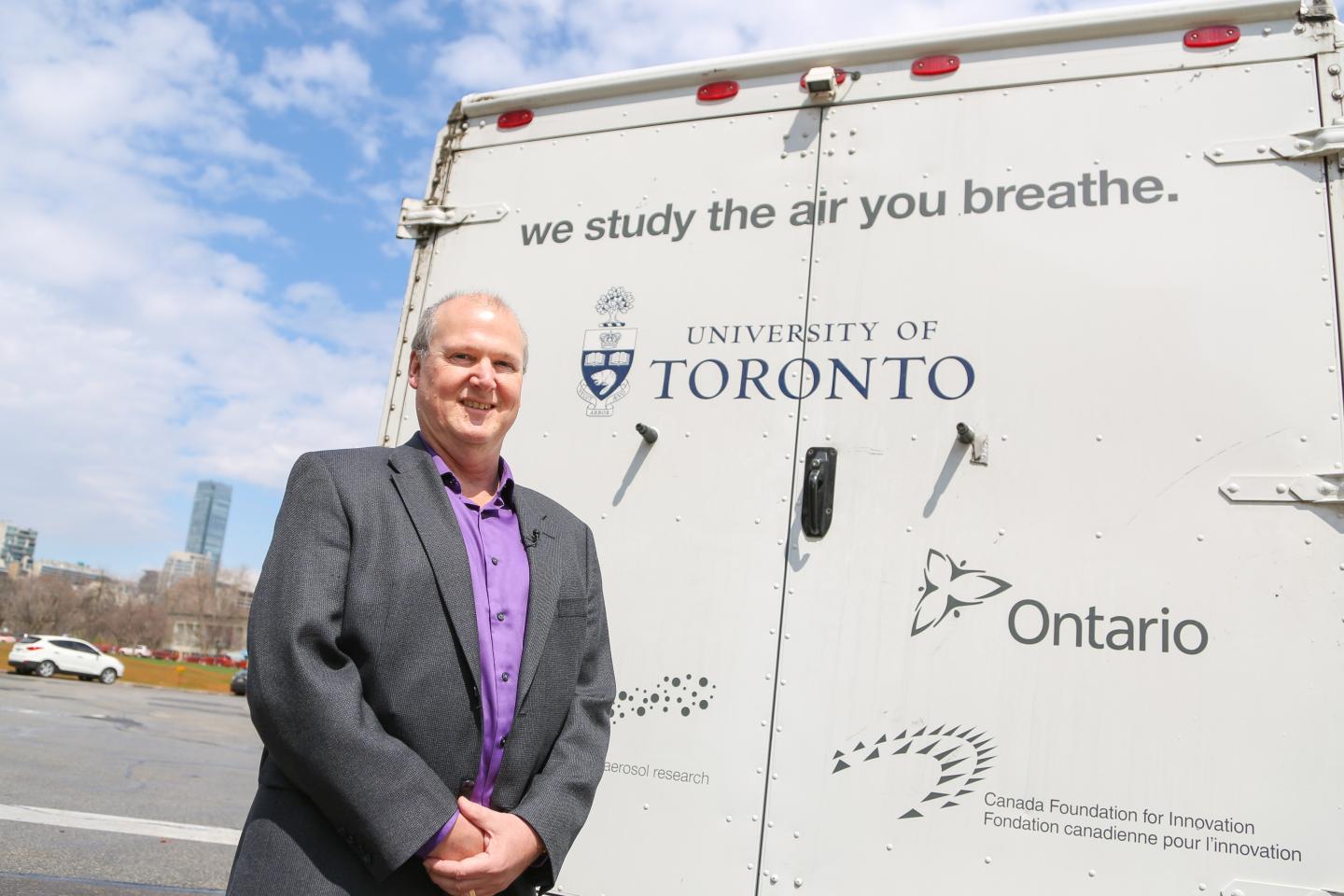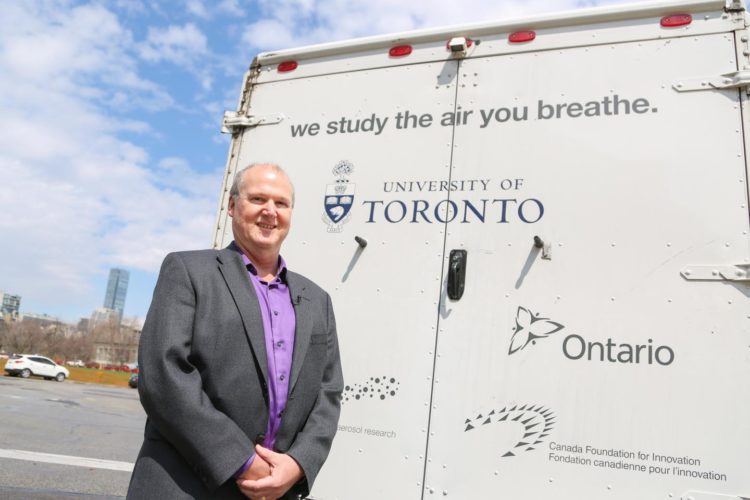Study of near-road air pollution in Canadian cities raises questions about health risks to one-third of population living near a major roadway

Credit: Roberta Baker, University of Toronto Engineering
Almost one third of Canadians live near a major road — and this means they go about their everyday lives exposed to a complex mixture of vehicle air pollutants.
A new national study led by University of Toronto Engineering researchers reveals that emissions from nearby traffic can greatly increase concentrations of key air pollutants, with highly polluting trucks making a major contribution. Canada’s cold winters can also increase emissions while particle emissions from brakes and tires are on the rise.
The report, released today, is the culmination of a two-year study monitoring traffic emissions in Toronto and Vancouver — the two Canadian cities with the highest percentage of residents living near major roads.
“There’s a whole ‘soup’ of pollutants within traffic emissions,” says Professor Greg Evans, who led the study in collaboration with Environment and Climate Change Canada, the Ontario Ministry of the Environment, Conservation and Parks, and Metro Vancouver.
Evans says that this soup of pollutants includes nitrogen oxides, ultrafine particles, black carbon, metals, carbon monoxide and carbon dioxide. Exposure to these emissions has been associated with a wide range of health issues, including asthma, cancer and cardiovascular mortality.
“The areas of concern we identified raise important questions about the health of Canadians living near major roadways,” says Evans.
The national report’s findings complement a parallel report on air quality in the Vancouver region that will soon be released by Metro Vancouver. Both reports underscore the need to assess and enact new measures to mitigate exposure to air pollutants.
— Traffic in cities —
Busy roads are detracting from air quality nearby, especially during morning rush hour.
The researchers measured concentrations of ultrafine particles — the smallest airborne particles emitted by vehicles — and found that average levels of ultrafine particles near highways were four times higher than sites far removed from traffic.
“These particles are less than 100 nanometres in size, much smaller than red blood cells. They can travel and trans-locate around the body,” explains Evans. “We don’t know yet what the health impacts of these particles are but we do know that near roads, they are a good indicator of exposure to traffic pollution.”
The concentrations of most traffic pollutants varied by factors of two to five across the cities.
— Large trucks —
The report highlights the dangers of highly polluting diesel trucks, which represent a minority of the total trucks on roads and highways, but emit diesel exhaust at disproportionately high levels.
“If there’s a high proportion of trucks, people who spend a lot of time near these roadways — drivers, workers, residents –are being more exposed to diesel exhaust, which is a recognized human carcinogen,” says Evans.
Though there’s currently no standard for public exposure to diesel exhaust in Canada, black carbon, more commonly called soot, is used to monitor exposure in workplaces. Based on black carbon, the concentrations of diesel exhaust beside the major roads exceeded the guidelines proposed in the Netherlands for workers, implying that they are too high for the public.
“If these highly polluting diesel trucks were repaired, retrofitted, removed or relocated, it would make a significant difference,” says Evans. “You can’t move your nearby schools or homes, but we can do something about these highly-polluting trucks that are a small proportion of the truck traffic, and yet causing a lot of the trouble.”
— Wind and winter —
Air quality is not just a concern during summer months: winter weather brings an increase in near-road concentrations of nitrogen oxides and ultrafine particles.
The researchers’ data suggest emission treatment systems on diesel vehicles become less effective under colder temperatures. “The systems appear to not be well designed for cold weather,” says Evans. “It’s concerning when you consider most of Canada faces cold temperatures and long months of winter; Toronto and Vancouver are nowhere near the coldest parts of Canada.”
Wind conditions also affect pollutant levels: the researchers found that concentrations were up to six times higher when monitoring the downwind side of a major road.
— Tire and brake wear —
As brake pads on cars and trucks are worn down, the materials they’re made of turn to dust — and that dust goes straight into the air.
“These non-tailpipe emissions, from brakes, tires and the road itself, are increasing and we believe that this is because our cars are getting larger and heavier,” says Cheol Jeong, Senior Research Associate in Evans’ lab, whose analysis revealed the growing issue with non-tailpipe emissions.
“People are buying more trucks and SUVs than small cars and that trend has been growing in recent years. The heavier it is, the more energy it takes to stop, and the more brake dust gets emitted,” he adds.
The report concludes with recommendations geared at all levels of government. Evans hopes the report will lead to establishing a nation-wide road-pollution research network that can advise policymakers, engage companies and the public, and lead to standards and laws that will ultimately protect the health of Canadians.
“We’d like to see this report, and future studies, help launch new monitoring stations across Canada so that all Canadians can get a better picture of the implications of our transportation choices and how these influence what we’re breathing in,” he says. “Our transportation will be changing very quickly in the coming decade and we’ll need ongoing monitoring to help us stay on a path towards increased sustainability.”
The findings of this report and its recommendations will be discussed at a national meeting in Toronto on November 4.
###
Media Contact
Liz Do
[email protected]
416-946-7257






